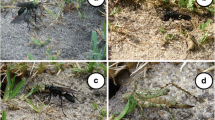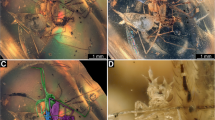Abstract
Several species of Berothidae are known to be specialist predators of termites during their larval stages. A female of the Japanese berothid Isoscelipteron okamotonis (Nakahara, 1914) was captured in the field and laid eggs in captivity. Of 67 eggs, 20 hatched into larvae, 3 of 9 which pupated and 1 of which reached the adult stage. The first and third instars preyed on workers of the termite Reticulitermes speratus, although the second instars did not. Larvae did not show the specific predatory behaviors observed in Northern American relatives. Instead, they bound paralyzed termites with silk that was apparently used for hunting. This is the first record of an Old World berothid raised from egg to adult in the laboratory.

Similar content being viewed by others
References
Adams P.A. 1989. A new genus of Berothidae from tropical America, with two new species. Psyche 96: 187–194
Ardila-Camacho A. 2013. First record of beaded lacewings (Neuroptera, Berothidae) from Colombia. Zootaxa 3669: 159–164
Aspöck U. 1986. The present state of knowledge of the family Berothidae (Neuropteroidea: Planipennia). In: Recent Research in Neuropterology (Gepp J., Aspöck H. and Hölzel H., Eds), Privately printed, Graz, Austria, pp 87–101
Aspöck U. and Aspöck H. 1980. Das Genus Isoscelipteron Costa 1863 (Neuropteroidea: Planipennia: Berothidae). Z. Arbeitsgem. Öst. Entomol. 32: 65–74
Aspöck U. and Aspöck H. 1991. Zur Kenntnis des Genus Isoscelipteron Costa, 1863 (Neuropteroidea: Neuroptera: Berothidae: Berothinae). Z. Arbeitsgem. Öst. Entomol. 43: 65–76
Aspöck U. and Nemeschkal H.L. 1998. A cladistic analysis of the Berothidae (Neuroptera). Acta Zool. Fennica 209: 45–63
Azar D. and Nel A. 2013. A new beaded lacewing from a new Lower Cretaceous amber outcrop in Lebanon (Neuroptera: Berothidae). In: Insect Evolution in an Amberiferous and Stone Alphabet (Azar D., Engel M.S., Jarzembowsky E., Krogmann L., Nel A. and Santiago-Blay J., Eds), Brill, Leiden, pp 111–130
Bisby F.A., Roskov Y.R., Orrell T.M., Nicolson D., Paglinawan L.E., Bailly N., Kirk P.M., Bourgoin T., Baillargeon G. and Ouvrard D. 2011. Species 2000 & ITIS Catalogue of Life: 2011 Annual Checklist. http://www.catalogueoflife.org/annual-checklist/2011/search/all/key/isoscelipteron/match/1
Brushwein J.R. 1987. Bionomics of Lomamyia hamata (Neuroptera: Berothidae). Ann. Entomol. Soc. Am. 80: 671–679
Hayashi F. 2005. Libellulidae, Raphidioptera, Neuroptera. In: Insect Larvae of Japan (Hayashi N., Ed), Gakken, Tokyo, pp 26 (in Japanese)
Johnson J.B. and Hagen K.S. 1981. A neuropterous larva uses an allomone to attack termites. Nature 289: 506–507
Kistner D.H. 1982. The social insects’ bestiary. In: Social Insects vol. III (Hermann H.R., Ed), Academic Press, New York. pp 1–244
Kollar V. 1837. Naturgeschichte der schädlichen Insekten. Verh. kaiserlich-königlichen Landwirthsch.-Ges. Wien 5: 411–413
Komatsu T. 2013. Some new finding on ecology of Japanese beaded lacewing, Isoscelipteron okamotonis (Neuroptera: Berothidae). Gekkan-Mushi 508: 24–26 (in Japanese)
MacLeod E.G. and Adams P.A. 1967. A review of the taxonomy and morphology of the Berothidae, with the description of a new subfamily from Chile (Neuroptera). Psyche 74: 237–265
Monserrat V.J. 2006. Nuevos datos sobre algunas especies de la familia Berothidae (Insecta: Neuroptera). Heteropterus Rev. Entomol. 6: 173–207
New T.R. 1989. Planipennia. Lacewings. Handbuch der Zoologie (Berlin) 4: 1–132
New T.R. 1991. Neuroptera (lacewings). In: The Insects of Australia, 2nd edition, Volume 1 (Naumann I.D., Ed), Melbourne University Press, Melbourne, pp 525–542
Sekimoto S. 2008. Isoscelipteron okamotonis (Nakahara). In: Iconographia Insectorum Japonicorum Colore Naturali Edita III (Hirashima Y. and Morimoto K., Eds), Hokuryukan, Tokyo, pp 240 (in Japanese)
Takematsu Y. 1999. The genus Reticulitermes (Isoptera: Rhinotermitidae) in Japan, with description of a new species. Entomol Sci 2: 231–243
Tauber C.A. and Tauber M.J. 1968. Lomamyia latipennis (Neuroptera: Berothidae) life history and larval descriptions. Can. Entomol. 100: 623–629
Tsukaguchi S. 1997. Nihon-san Myakushi-moku Kamei-hyou (translation: List of families of Japanese Neuroptera. In: The Encyclopaedia of Animals in Japan (9) Insect 2 (Ishii M., Ohtani T. and Johki Y., Eds), Heibonsha, Tokyo, pp 16–17 (in Japanese)
Wedmann S., Makarkin V.N., Weiterschan T. and Hörnschemeyer T. 2013. First fossil larvae of Berothidae (Neuroptera) from Baltic amber, with notes on the biology and termitophily of the family. Zootaxa 3716: 236–258
Acknowledgments
I thank Shouhei Ueda and Tetsuya Yamamoto for helping to rear insects and Joseph Parker for reviewing this manuscript.
Author information
Authors and Affiliations
Corresponding author
Rights and permissions
About this article
Cite this article
Komatsu, T. Larvae of the Japanese termitophilous predator Isoscelipteron okamotonis (Neuroptera, Berothidae) use their mandibles and silk web to prey on termites. Insect. Soc. 61, 203–205 (2014). https://doi.org/10.1007/s00040-014-0346-6
Received:
Revised:
Accepted:
Published:
Issue Date:
DOI: https://doi.org/10.1007/s00040-014-0346-6




